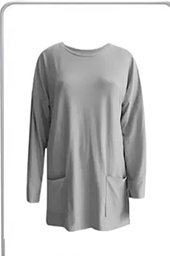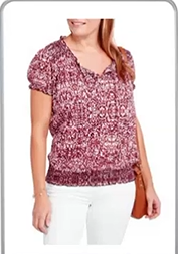The Step-by-Step Classification Process
Introduction: Your Path to Accurate Classification
Welcome. This guide is designed to give you a clear, systematic path for classifying knit upper-body garments. We will use a simple, question-based process that demystifies one of the more complex areas of textile classification. It’s important to note that significant changes to the Harmonized Tariff Schedule (HTS) in 2022 fundamentally altered how we approach headings 6106 (Blouses & Shirts) and 6110 (Sweaters & Pullovers), making a structured method more critical than ever. This guide will walk you through the exact sequence of checks used by import specialists, from initial “knock-out” rules to detailed feature analysis, ensuring you arrive at an accurate and defensible classification every time.
——————————————————————————–
1. The First Decision Gate: The “Knock-Out” Questions
Before you analyse any other feature of a garment, your first and most efficient step is to check for three specific characteristics. These are “knock-out” rules that immediately exclude a garment from consideration under heading 6106. Making these checks first saves you from doing unnecessary work; if a garment fails here, there is no need to count the stitches.
1.1. Question 1: Does the garment have pockets below the waist?
If the answer is Yes, the analysis for heading 6106 stops immediately.

According to Note 4 to Chapter 61, heading 6106 does not cover garments with pockets below the waist.
A garment with pockets below the waist is definitively excluded from 6106. You will then consider other classifications, such as a jacket or a cardigan of heading 6110.
1.2. Question 2: Does the garment have a ribbed waistband or other means of tightening at the bottom?

If the answer is Yes, the analysis for heading 6106 stops.
According to Note 4 to Chapter 61, heading 6106 does not cover garments with a ribbed waistband or other means of tightening at the bottom.
However, there is a critical nuance here clarified by Customs Headquarters (HQ) rulings (H334342, H966819, and H952707). The mere presence of a rib knit bottom is not enough for exclusion. The feature must actually cause the garment to gather or secure against the wearer’s body. A powerful counter-example is button tabs that actually increase the width at the bottom; these are definitively not a means of tightening. If the ribbed bottom is loose and extends away from the body, it is not considered a means of tightening.
This table clarifies the distinction:
| Feature | Considered “Tightening”? | Consequence for 6106 |
| Ribbed bottom that gathers on a mannequin | Yes | Excluded from 6106 |
| Loose ribbed bottom that extends away from body | No | Not excluded from 6106 |
If your garment has passed these first two checks, the next critical test is the stitch count.
——————————————————————————–
2. The Second Decision Gate: Counting the Stitches
After confirming the garment is not excluded by pockets or a tightening bottom, the stitch density is the next mandatory check required for consideration under heading 6106.
2.1. Question 3: Does the garment have an average of 10 or more stitches per linear centimeter?
If the answer is No (meaning, it has an average of less than 10 stitches), the analysis for heading 6106 stops.
According to Note 4 to Chapter 61, heading 6106 does not cover garments “having an average of less than 10 stitches per linear centimeter in each direction.”
A garment with a stitch count below this threshold cannot be a shirt or blouse of 6106. It will be considered under other headings, such as 6109 (T-shirts) or 6110 (Sweaters, pullovers), provided it meets the criteria for those headings.
2.2. How to Correctly Count Stitches
Obtaining an accurate stitch count is a foundational skill. Follow this procedure carefully:
1. Prepare the Garment: Lay the garment on a flat surface. Ensure the fabric is not stretched in any direction.
2. Identify the Fabric: Note the knit type (e.g., jersey, rib knit, double knit). This is essential for a proper count.
3. Count Rib Knits Correctly: This is a common point of error. For rib knits, you must count both the plain stitches (the “hills”) and the purl stitches (the “valleys”), even if the purl stitches are sometimes obscured by the knit stitches due to tension in the fabric.
4. Position Your Tool: Place your pick glass or ruler in a central area of the garment, such as the center back or chest. Avoid counting near cuffs, waistbands, or shoulders, as the fabric in these areas can be distorted.
5. Count the Stitches: Count the stitches (also known as wales) across the fabric in the horizontal direction. If necessary, you can also turn your tool to count the courses in the vertical direction.
If your garment has 10 or more stitches per centimeter, you have confirmed it is potentially a 6106 garment. The final step is to analyze its specific features to determine its identity as a shirt or blouse.
——————————————————————————–
3. The Final Analysis: Is It a Shirt or a Blouse?
Once a garment has successfully passed the knock-out tests and the stitch count requirement, the final step is to determine if it is a shirt, shirt blouse, or blouse. All of these fall under heading 6106, but understanding their definitions is key to proper classification.
3.1. Defining the Garment Types
While the legal notes define blouses as “loose fitting,” they do not specify a fit for shirts. However, expert practice and textile guidelines provide context: the construction of shirts and shirt blouses tends to be a little bit more tailored than blouses.
The legal notes provide these defining characteristics:
| Feature | Blouses (6106) | Shirts & Shirt Blouses (6106) |
| Fit | Described as loose fitting | Tend to be more tailored, but can be loose |
| Sleeves | Can be sleeveless, short, or long | Must have long or short sleeves |
| Opening | Can be with or without an opening | Must have a full or partial opening from the neckline |
| Collar | May have a collar, hood, or no collar | May have a collar, hood, or no collar |
3.2. Applying the Definitions: A Logic Flow
Use the following logic flow to make your final determination:
• If the garment is loose-fitting AND sleeveless… then it can only be a blouse.
• If the garment is loose-fitting AND has no opening at the neckline… then it is a blouse.
• If the garment has long or short sleeves AND a full or partial opening… then it can be a shirt or a blouse.
• If the garment is not loose-fitting… then it is excluded from 6106 and is classified in another heading, such as 6110 for pullovers, provided it meets the criteria for that heading.
3.3. A Special Note on “Loose-Fitting”
“Loose-fitting” is a critical—and historically subjective—term that has now been clarified by CBP. As established in HQ Ruling 951900, the official test is to place the garment on a standard size 10 mannequin. This was instituted “to maintain consistency throughout the examination process” and to avoid subjective classifications based on photos.
The core principle is this: If the garment does not cling close to the mannequin, it is considered loose-fitting. This objective test means that even a standard looking sweatshirt type garment that in the past would not even be considered a blouse can now be correctly classified under 6106 if it is loose-fitting and meets the other criteria of the heading.
——————————————————————————–
4. Summary: Your 3-Step Classification Flowchart
To recap, your entire decision-making journey for classifying a knit upper-body garment under heading 6106 can be summarized in this three-step flow:
1. Check for Exclusions: First, look for pockets below the waist or a tightening feature at the bottom. If either is present, stop. It is not a 6106 garment.
2. Count the Stitches: Next, ensure there are 10 or more stitches per linear centimeter in each direction. If not, stop. It is not a 6106 garment.
3. Analyze the Features: Finally, examine the fit, sleeves, and neckline opening to determine if it is a blouse or a shirt within heading 6106. Remember that being sleeveless or having no opening automatically makes it a blouse, provided it is also loose-fitting.NotebookLM can be inaccurate; please double check its responses.

Comments